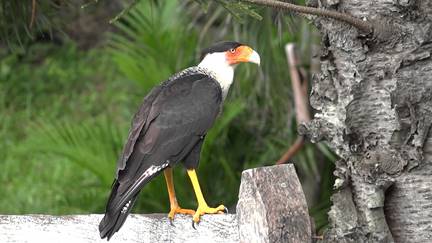At time the Carrancha is noisy, but is not generally so: its cry is loud, very harsh and peculiar, and may be liken to the sound of the Spanish guttural g, followed by a rough double r, when uttering this cry it elevates its head higher and higher, till at last, with its beak wide open, the crown almost touches the lower part of the back. This fact, which has been doubted, is quite true; I have seen them several times with their heads backwards in a completely inverted position. –Voyage of the Beagle, Charles Darwin.
The crested caracara looks like a thin hawk with a sharp beak and talons, behaves like a vulture, but is technically a large tropical falcon. It is easily recognizable as it stands tall on long, yellow-orange legs with a distinct black cap and orange bill. It is a bird of open country present throughout South America, Central America, Cuba, through Mexico and into southern Arizona, Texas, and Florida.
They have a wingspan of 42-51 inches and a total length of 19-23 inches. They weigh about 2.5 pounds. There is some disagreement in the scientific community as to whether this species should be split into two species – a northern and southern one. The jury seems to be out yet on this question.
These birds are commonly found in open savannahs and woodlands from sea level up to 10,000 feet. They avoid areas of dense undergrowth as they need a bit of a running start to get into the air. Caracaras regularly walk or run on the ground.
Adults have a distinctly bicolored head with a black crown, while lower head, and black body with a streaked breast. The bill is a bright orange with a blue tip. Juvenile birds are dull brown without the prominent streaked breast of the adult. The oldest bird on record was 21 years, 9 months old and was originally banded in Florida.
Though they are thought to primarily eat carrion, crested caracaras also eat live prey including insects, fish, reptiles, amphibians, birds, and mammals. So – generally they will eat most anything they encounter. They are known to wander in shallow water to grab fish, dig up turtle eggs with their feet and turn over debris in search of insects. They will follow farm equipment to snatch up fleeing animals.
Because they cannot open up a large carcass on their own they will wait around for a vulture or large animal to do so and then feed upon the unearned bounty. Unlike most raptors that pounce on prey, caracaras generally fly or run on the ground toward their prey until they overtake it. They also regularly cruise along highways looking for roadkill. They have been observed stalking birds as large as cattle egrets.
A biologist watching nest in Costa Rica noted that a prey item was brought to the nest at a rate of one item per hour and included birds, a cotton rat, lizards, a large frog, fish, and various large insects and a tarantula. The scientific name is derived from poly, the Greek word for many or varied; boros, meaning gluttonous and refers to the bird’s voracious appetite; and from the Latin plancus, which is a word Aristotle used for an eagle. They are generally pretty quiet but have a rattling call they make when tossing back their head. Call

Crested caracaras are the only member of the falcon family that build a nest of twigs and branches. All others simply scratch out a space on steep cliff ledges.
Pairs form year-round bonds and stay together for several years. Pairs and family groups frequently preen one another – known as allopreening.
Pairs maintain strict territorial boundaries and will defend these from intruders. They are faithful to the nest site, often returning to the same tree year after year. Crested caracaras will build a nest in a tall tree, shrub, cactus, or atop a structure. Both sexes contribute to the construction of the nest and takes about 2 weeks to build. One to 4 eggs are laid and incubation takes about 30 days. The young fledge in 40 days and may stay around the nest for a year in a family group.
I’ve seen these birds in the Andes and the flatlands of Chile and remember a small flock of them just wandering around the grounds of Isla Maillen, near Puerto Montt, looking for leftovers from the visitors. They were not quite as tame as pigeons but were a rather creepy sight when 6 of them would circle you when you sat on the ground with your lunch. Get outta here!
Driving along some steep mountain roads in the Apalobamba Range of Bolivia we would see them regularly in the barren landscape. Pedro, a local Aymara climber introduced to me by a friend, was traveling with us. He would see a crested caracara and say Santa Maria – in the mix of Christian and Aymara folklore (Aymara is the indigenous culture that worships Pachamama – the earth mother) – as he noted the birds were mal suerte – bad luck.
Later we were climbing a steep grade, just after the corner everyone referred to as “where that truck rolled down the hill” (800 ft. and is still there) and Pedro saw a caracara sitting on a rock and said – buena suerte!
I said Que?! Espere!
I thought you said they were BAD luck not GOOD luck. But apparently I was not being observant enough to note the subtle difference in his distinctions. Pedro, in a mild tone of pity that I could not figure this out on my own, said that the brown juveniles were bad luck but that an adult bird was good luck.
Well, ok then! I’m glad we cleared that up.
